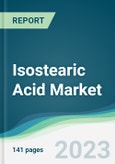The isostearic acid market is estimated to grow at a CAGR of 6.42% during the forecast period.
Isostearic acid is a chemical compound derived from the fatty acids found in vegetable oils. It is characterized by its highly branched structure, providing it with a competitive advantage over other fatty acids. It is used as an additive in various applications, including personal care products such as lotions and creams and the production of plasticizers, coatings, and adhesives. In addition, its highly branched structure offers improved low-temperature performance characteristics, better oxidative stability, and enhanced lubricity, making it an ideal ingredient in producing high-performance lubricants. The manufacturing processes of chemical esters, lubricants and greases, cosmetics and personal care products, surfactants, and adhesives are the predominant applications of isostearic acid. The expansion of the personal care and construction sectors is expected to drive the demand for the isostearic acid market over the forecast period.Market Drivers
- Increasing demand for sunscreens
- Growing lubricants consumption
The fluctuations in raw material prices and the presence of substitutes remain key challenges.
The cost of the raw materials used to produce isostearic acid varies depending on supply and demand, weather patterns, and geopolitical events. A consequent rise in the cost of these raw materials due to such factors will further increase isostearic acid production expenditure, limiting its production by companies. Further, the availability of alternative ingredients, such as several other fatty acids and esters that can be used to replace isostearic acid as an emollient and surfactant in personal care products, is limiting the demand for isostearic acid and slowing the growth of the market. Hence, the cost uncertainty in manufacturing isostearic acid and availability of substitutes are also major restraining factors.Product Offerings:
- EMERSOL 3875 by Emery Oleochemicals-Emery Oleochemicals is a US-based chemical company that internationally manufactures and supplies a wide range of chemicals, including isostearic acid, under its product, EMERSOL 3875. This product is manufactured using sustainable sources and is extensively used to produce emollients and lubricants due to its cold temperature endurance and oxidation resistance properties.
- Isostearic acid by TCI Chemicals-TCI Chemicals is a Japan-based international chemical company that produces several organic chemical compounds, including isostearic acid. The company produces isostearic acid in liquid form in colors ranging from transparent to light yellow with a minimum purity of 90.0 %, packed in 25g and 500g packages.
- Jaric by Jarchem Industries Inc.-Jarchem Industries Inc. is a US-based chemical company that produces isostearic acid as its product, Jaric. The product manufactured is a cosmetic-grade product with enhanced stability properties as a long-chain acid.
By application, the chemical ester sector is expected to contribute majorly to the isostearic acid market.
The growing demand for chemical esters driven by the personal care and food & beverage sectors' expansion is expected to increase the market share of the chemical ester segment in the isostearic acid market. Chemical esters are compounds formed from the reaction of an alcohol and a carboxylic acid, forming an ester bond. Isostearic acid is particularly useful in this process due to its molecular structure, which enables it to react with a variety of alcohols to produce a wide range of chemical esters with desirable properties, including isostearyl isostearate, isopropyl isostearate, and glyceryl isostearate. The resulting chemical ester exposed to isostearic acid has enhanced viscosity, solubility, and emulsifying properties. In the food and beverage industry, chemical esters are used to produce flavors, whereas, in the personal care industry, they are extensively used to generate different fragrances.Asia Pacific region holds a substantial portion of the isostearic acid market and is expected to remain steady over the forecast period.
The isostearic acid market in the Asia Pacific region is stimulated by the expansion of its construction and cosmetics industries. The Indian Beauty and Hygiene Association estimated that India's personal care and cosmetics market will reach US$10 billion in 2021. In addition, the Indian Brand Equity Foundation projected that India's grooming and cosmetics industry will grow to US$20 billion by 2025. In addition, the rise in construction activities in the residential and commercial sectors of Asian economies fueled by the economic development of such nations is further increasing the demand for isostearic acid to manufacture lubricants, adhesives, and surfactants. For example, in September 2021, the Indian Government's Ministry of Finance department declared the initiation of the National Infrastructure Pipeline, which will last from 2020 to 2025, by investing approximately Rs 111 lakh crores in enhancing and aiding in development projects related to infrastructure in urban locations across the country.Market Segmentation:
By Application
- Chemical Esters
- Lubricants and Greases
- Cosmetics & Personal Care
- Surfactants
- Adhesives
- Others
By Geography
- North America
- USA
- Canada
- Mexico
- South America
- Brazil
- Argentina
- Others
- Europe
- Germany
- France
- United Kingdom
- Spain
- Others
- Middle East and Africa
- Saudi Arabia
- UAE
- Israel
- Others
- Asia Pacific
- China
- Japan
- India
- South Korea
- Indonesia
- Thailand
- Taiwan
- Others
Table of Contents
1. INTRODUCTION
2. RESEARCH METHODOLOGY
3. EXECUTIVE SUMMARY
4. MARKET DYNAMICS
5. ISOSTEARIC ACID MARKET BY APPLICATION
6. ISOSTEARIC ACID MARKET BY GEOGRPAHY
7. COMPETITIVE ENVIRONMENT AND ANALYSIS
8. COMPANY PROFILES
Companies Mentioned
- Sigma Aldrich
- TCI Chemicals
- Emery Oleochemicals
- Oleon NV.
- Jarchem Industries Inc.
- Croda International Plc
- KRATON CORPORATION
- KLK EMMERICH GmBH
- Santa Cruz Biotechnology, Inc.
- Vantage Specialty Chemicals
Methodology

LOADING...








